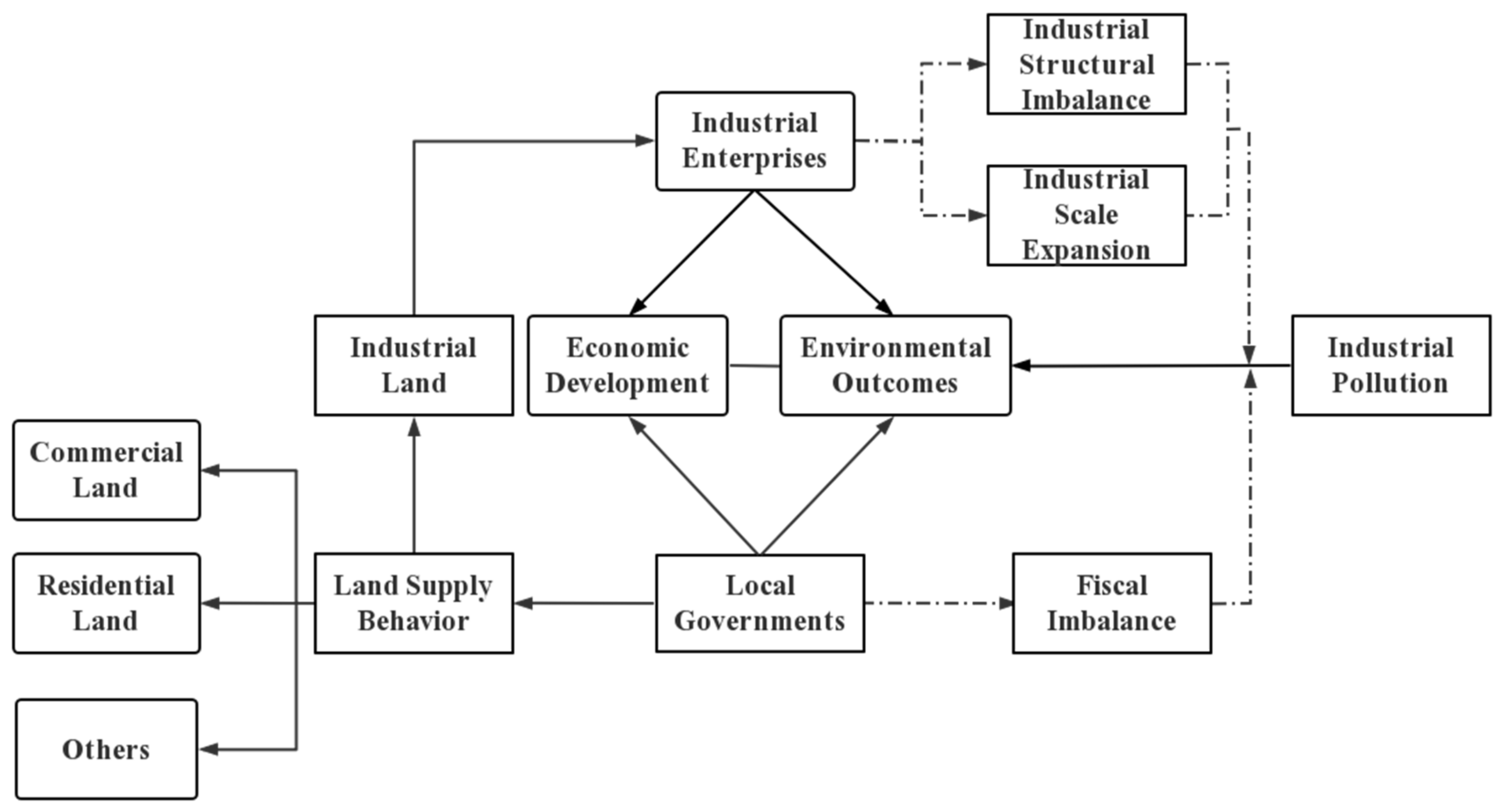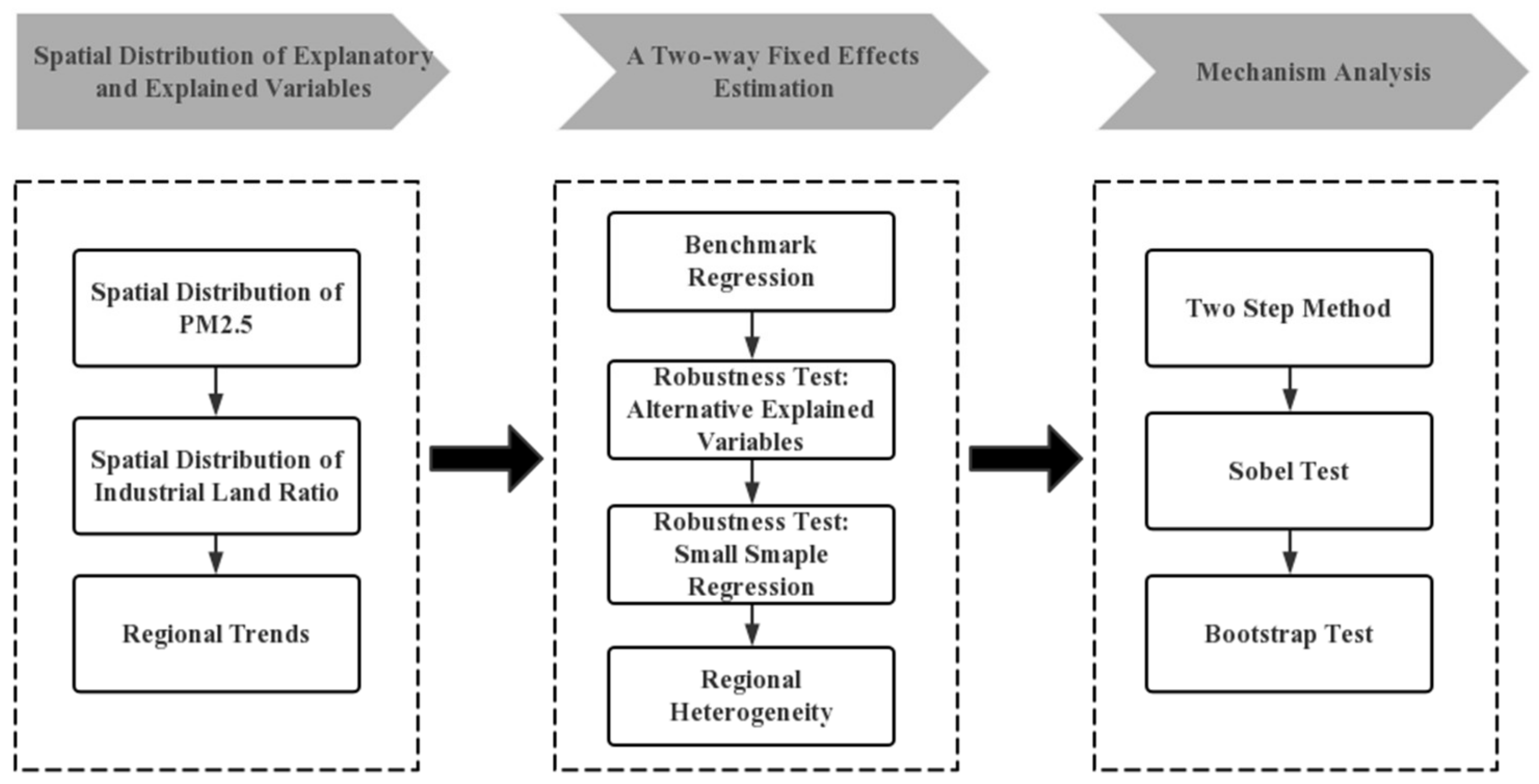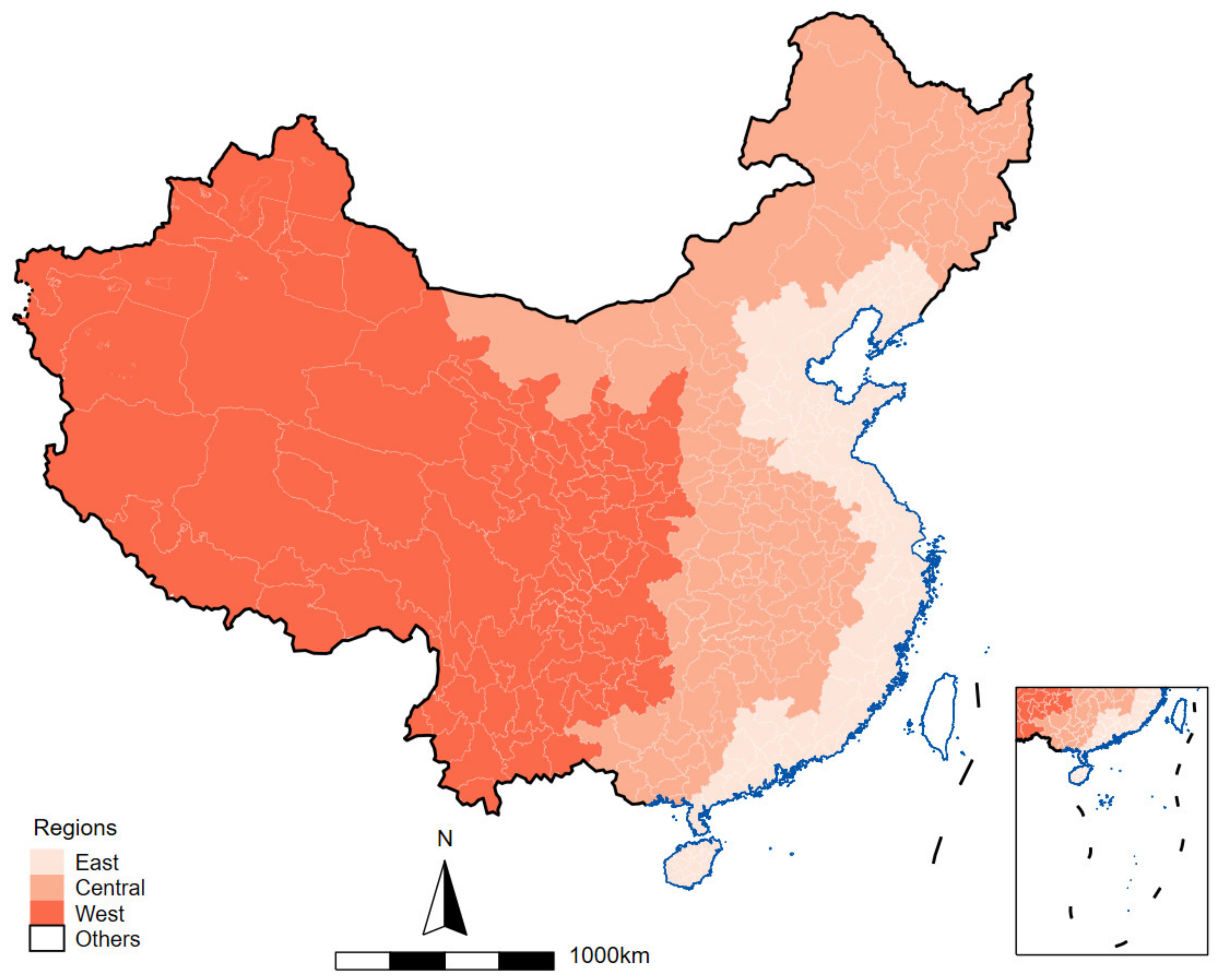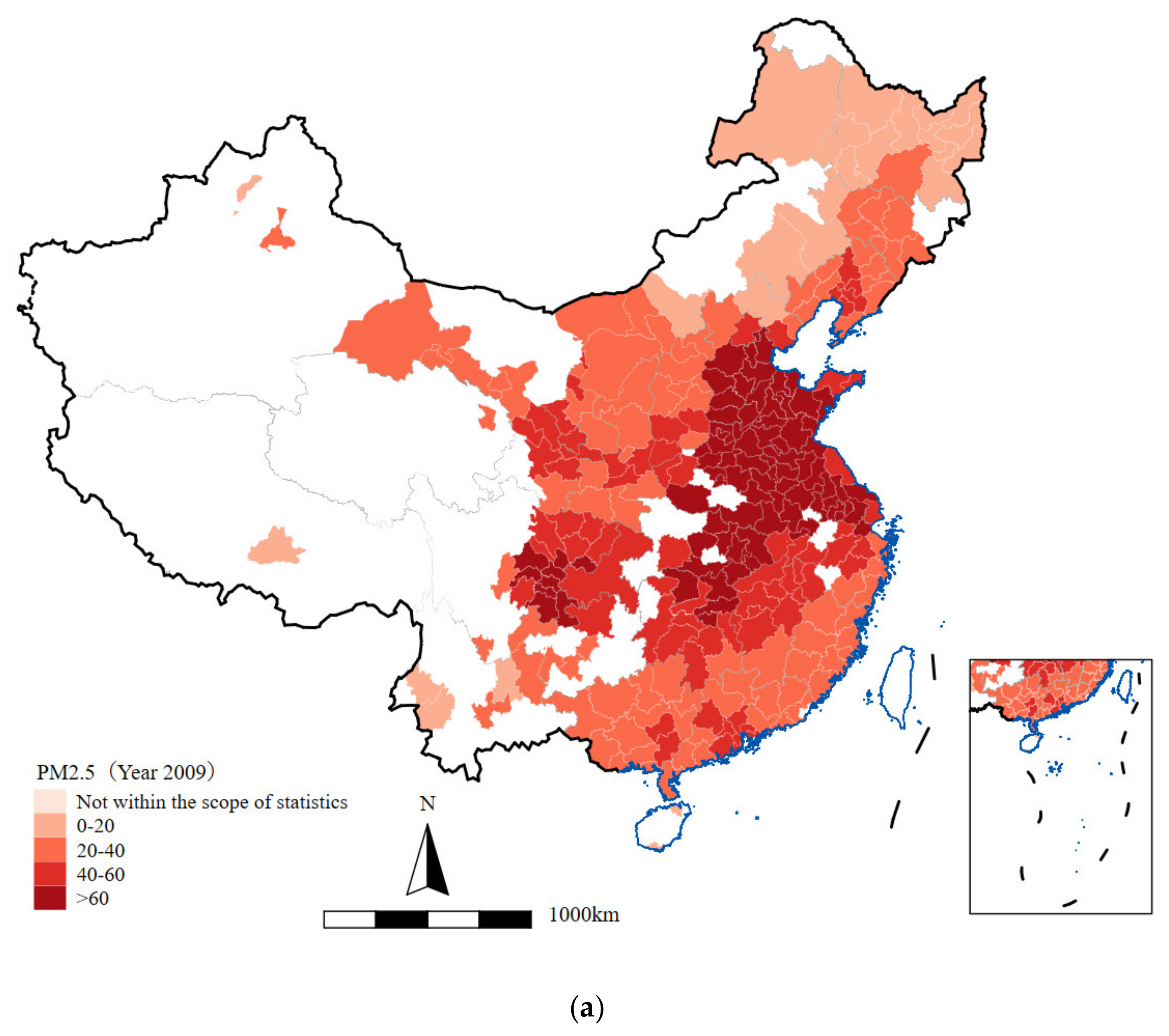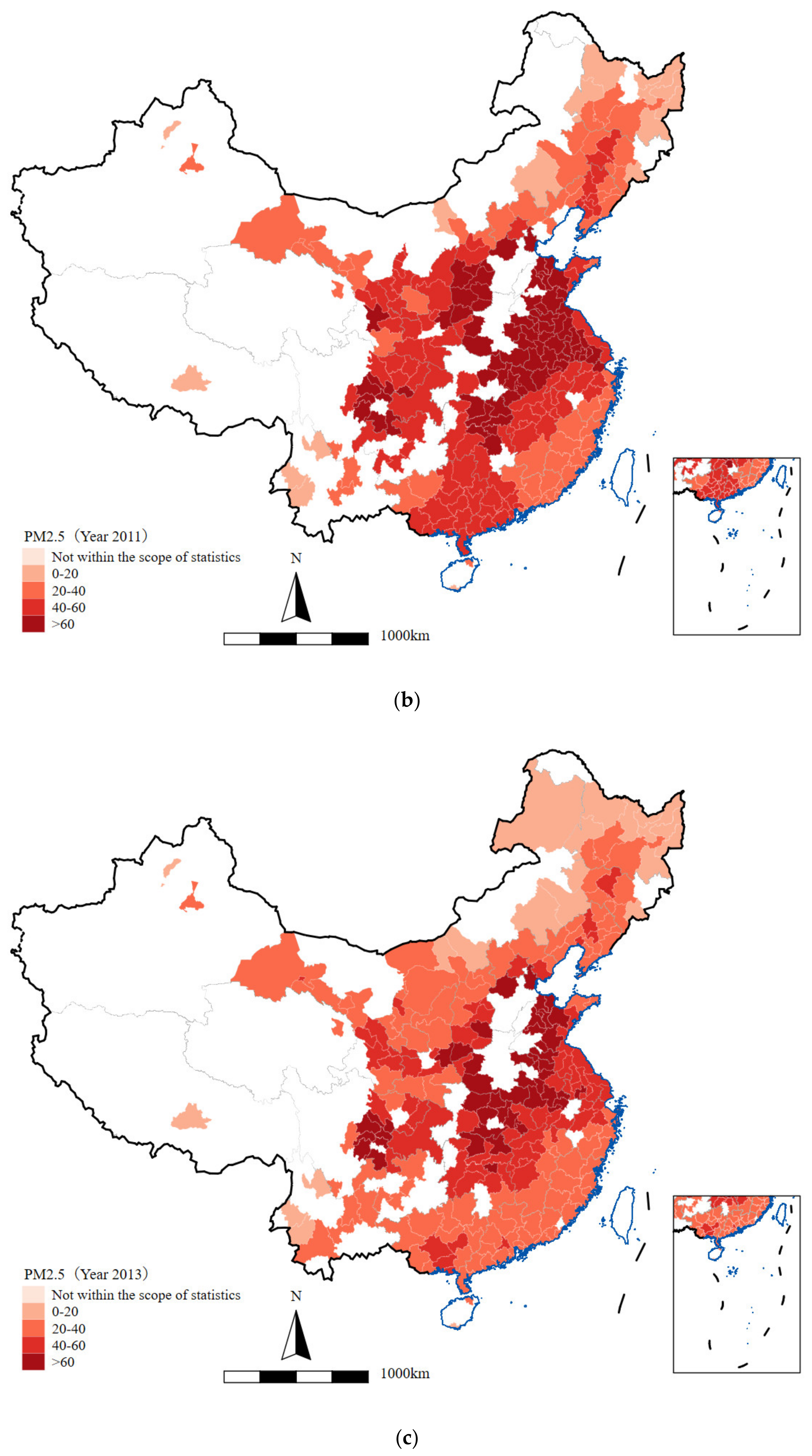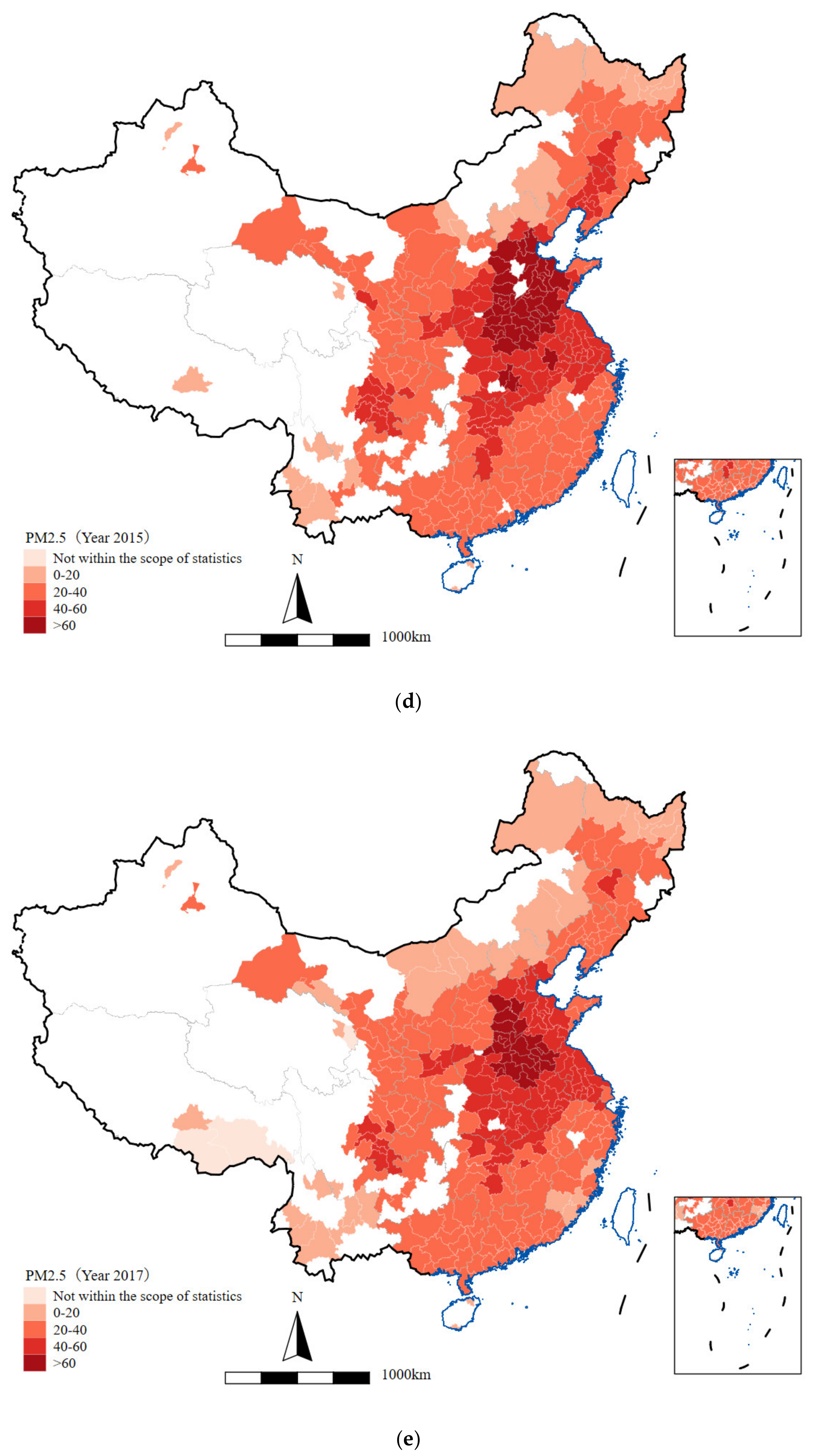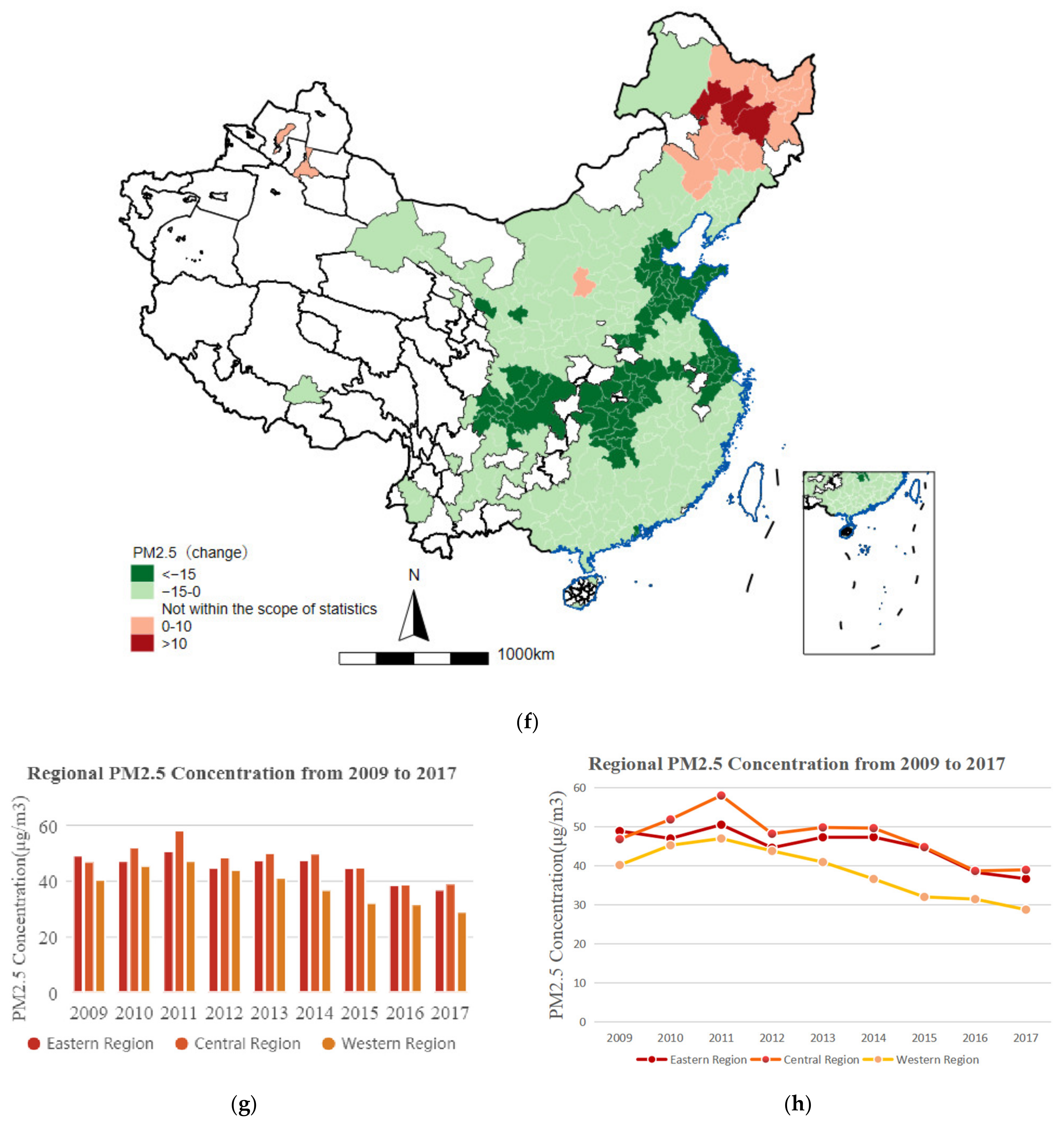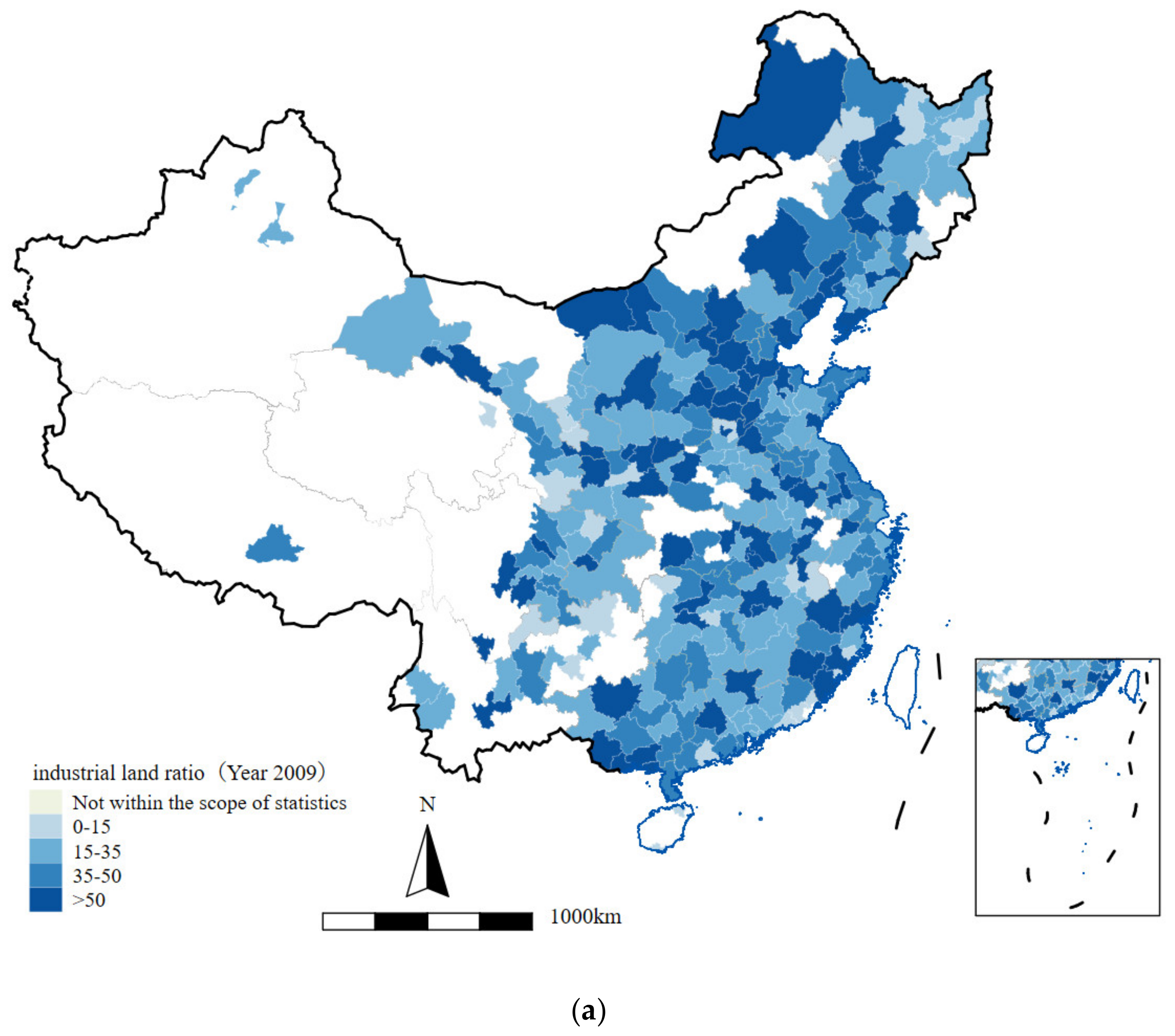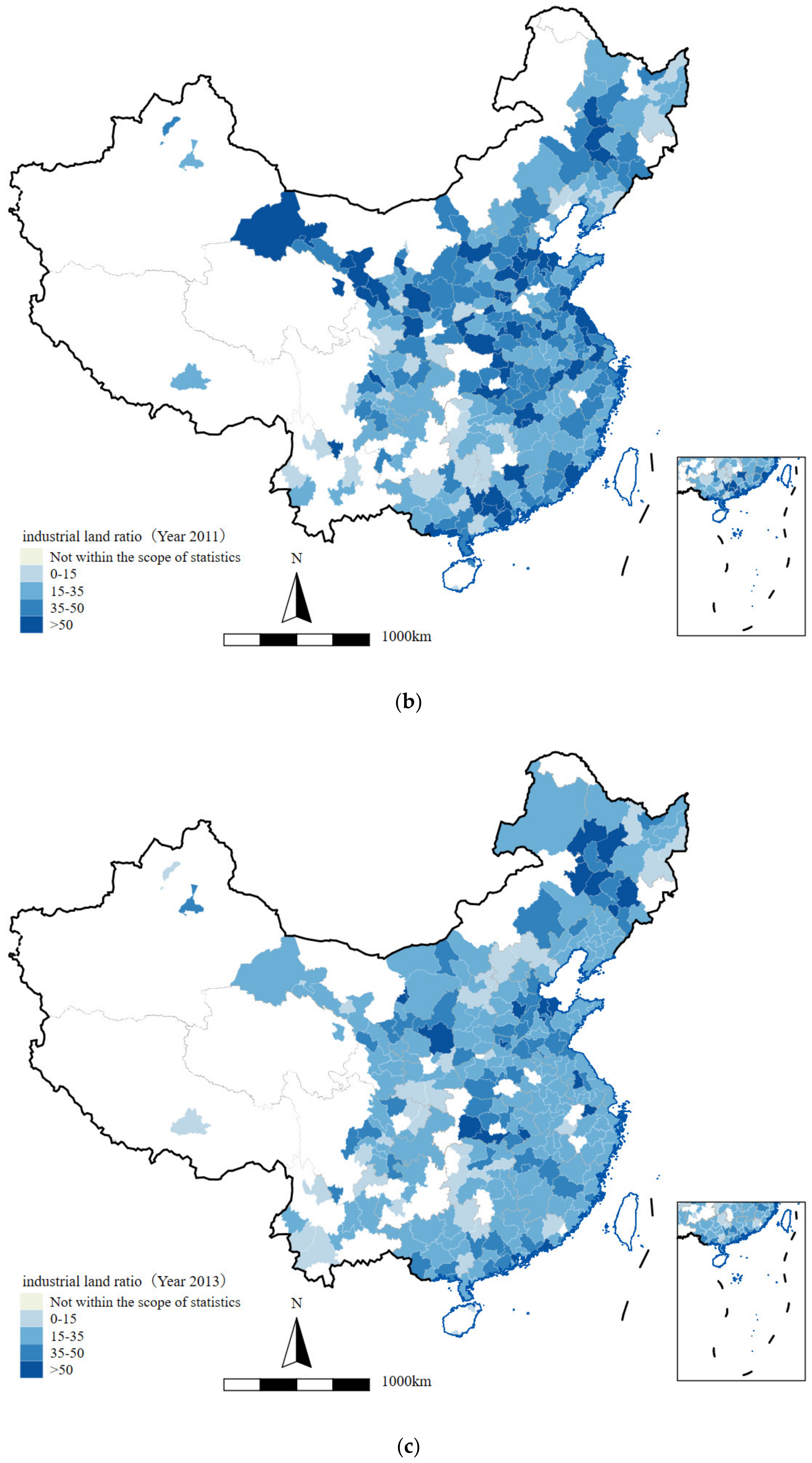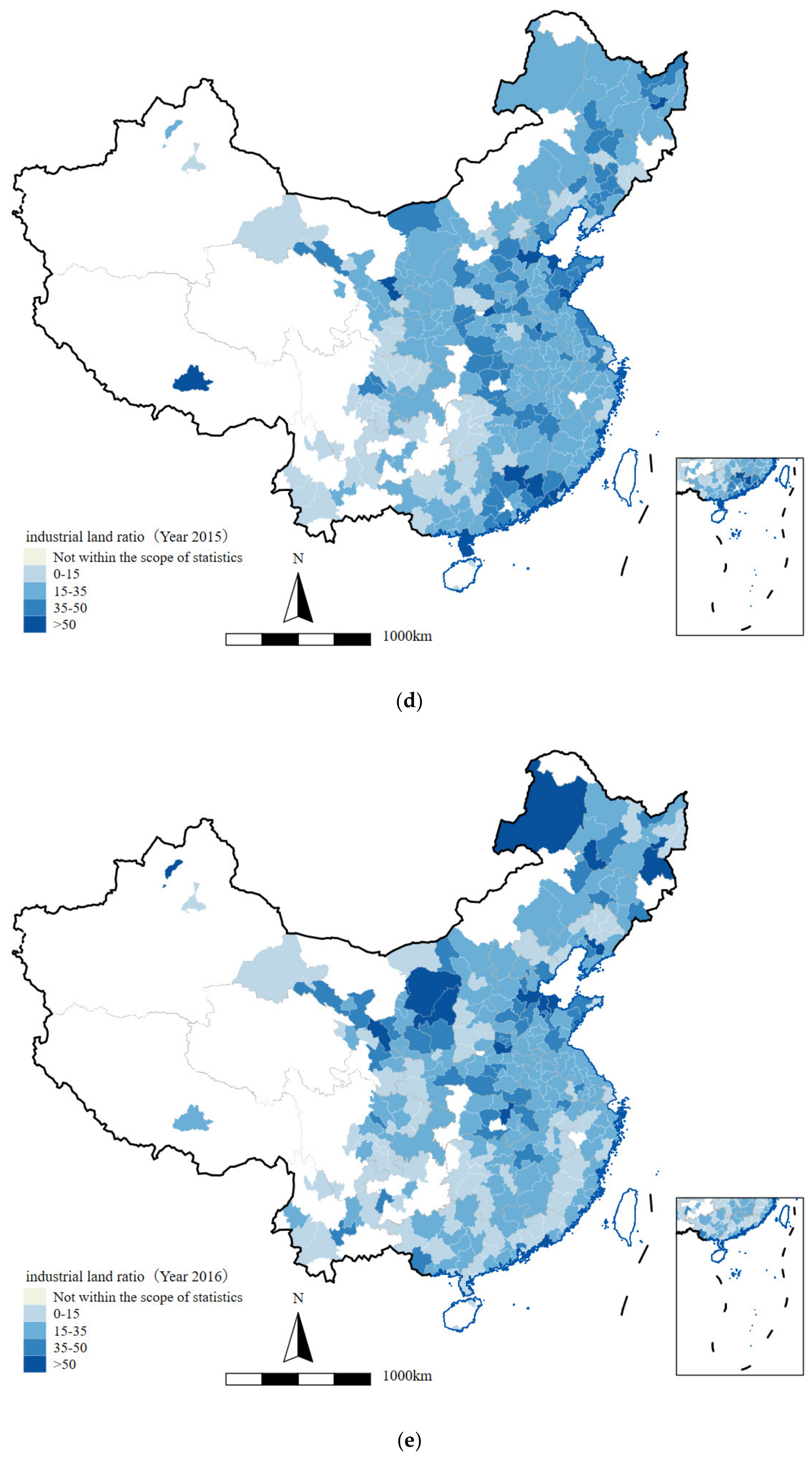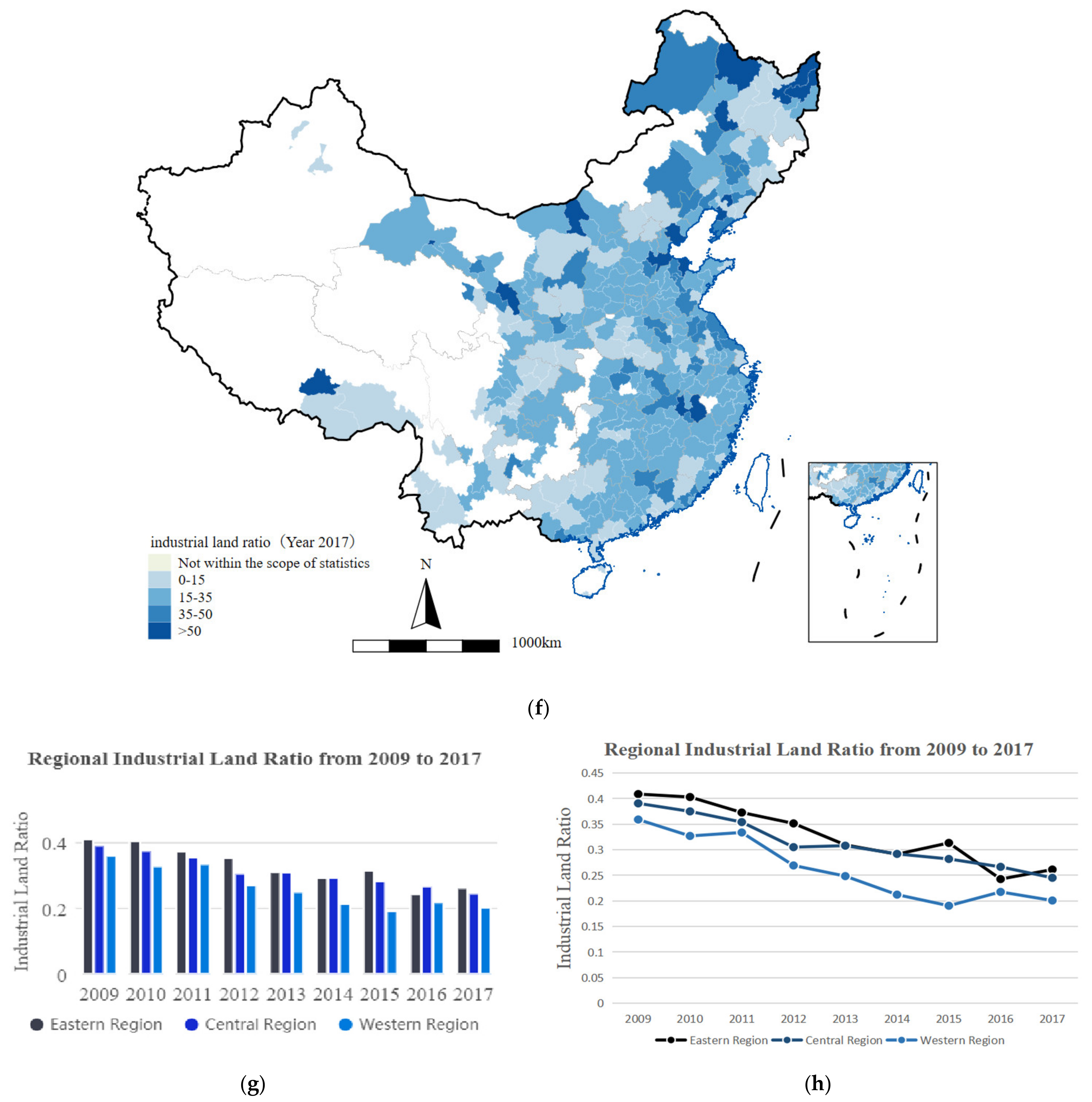1. Introduction
Economic growth and environmental pollution are key issues for policy makers and social scientists. The Chinese economy has grown very rapidly in the forty years following its “reform and opening” but at a large environmental cost. The Chinese economy is still at the left half of the environmental Kuznets curve (EKC), so it is crucial to consider both the country’s economic growth and the environmental protection needs [
1]. Based on the Bulletin on the State of Chinese Ecological Environment in 2020, only 56.7% of the country’s 337 prefecture-level cities meet government air quality standards and 83.4% of the national surface water sections satisfy the drinking water quality requirements. Therefore, air pollution and water pollution are still essential challenges for environmental protection and sustainable development. On the one hand, environmental pollution severely threatens people’s physical and mental health and carries enormous economic costs. On the other hand, with improvements in economic conditions and living standards, households now expect a higher quality of health and environment and are even willing to pay for this. The Chinese economy is now under urgent pressure to become sustainable and to combine high-quality growth with environmental protection and pollution control. It is also necessary to make efforts to solve the ecological problem from its root.
Existing research [
2,
3,
4] has recognized the important role of the local governments’ land resource allocation behavior on environmental problems. In the context of fiscal decentralization and the “GDP-growth tournament among governments”, local government officials are generally inclined to adopt the model of “developing through land” due to financial and political career promotion incentives [
2]. They tend to pursue regional economic growth goals and to maximize fiscal revenue without fully considering regional environmental protection and governance. Specifically, local governments tend to adopt the method of transferring industrial land by agreement and apply a low entry threshold for absorbing investment to attract industrial enterprises to the region and relax regional environmental regulations, which aggravates environmental pollution. In addition, the extensive development model of “land for capital” (selling industrial land cheaply) can quickly increase regional fixed asset investment, cultivate new tax sources, make up the gap between fiscal revenue and expenditure, and improve economic growth. With the advantage of a “two-way monopoly” in land transactions supported by China’s land property rights system [
5], local governments expropriate land from rural areas at a price lower than the land’s value and then supply land for real estate, commerce, and service industries at a high price to gain considerable land transfer fees. This differentiated land allocation strategy for industrial, commercial, and residential land is local governments’ optimal strategic choice to maximize their own utility. However, the resulting inefficient supply of industrial land, the damage to the ecological environment, and their regional heterogeneity need to be carefully evaluated; to date this has not happened.
To fill this gap, this study aims to investigate the impact of industrial land supply on environmental pollution in China through the combination of spatial analysis and regression models. We first use GIS to investigate the spatial variation of pollution and industrial land supply. We then apply a two-way fixed effects regression method to quantitatively evaluate the impacts of industrial land supply on environmental pollution. We further investigate the regional heterogeneity rigorously through group-level regressions to see whether the differentiated land allocation strategies adopted by local governments can aggravate regional environmental pollution. To test the robustness, we use alternative explained variables and narrow the samples successively. Further, we explore the intermediate mechanisms from three dimensions through a two-step method, the Sobel test, and the bootstrap test. Lastly, we provide policy implications for optimizing the allocation of land resources and improving land transfer regulations and environmental protection policies. The remainder of this paper is arranged as follows.
Section 2 reviews the literature on environmental pollution and land resource allocation. In this section, we first discuss the current situation of environmental pollution in China and then introduce the economy–environmental trade-off for local governments. Then, we analyze the incentives of industrial land supply behavior of local governments and the consequences on the local environment.
Section 3 explains our research design, data sources, empirical framework, and the variables used in this study. In
Section 4, we first provide spatial distributions of our explanatory and explained variables. Then, we present our empirical results.
Section 5 provides further analysis on regional heterogeneity and explores the mechanisms.
Section 6 concludes the study and provides policy recommendations.
2. Literature Review
Environmental pollution and its influential factors have been important topics of research among scholars around the world. Many researchers attempt to explain the evolution of environmental conditions from the perspective of economic development. Grossman and Krueger [
6] found that concentrations of sulfur dioxide and smoke initially increase with a per capita GDP at low levels of national income, then decrease with a higher per capita GDP, and finally level off with a per capita GDP of USD 8000 (1985 dollars). This inverted U-shaped relationship is commonly referred to as an environmental Kuznets curve (EKC). Hettige et al. [
7] found a similar inverted U-shaped relationship between GDP and the toxic intensity of manufacturing industries. Much other empirical research has proved the validity of EKC in different regions of the world, including North America [
8,
9] and South-West Europe [
10]. Some research has found similar results in China. For example, Wang and Huang [
11] found a U-shaped relationship between economic growth and air pollution in 112 cities in China. Using an ARDL model, Akram et al. [
12] found strong evidence of the EKC for China. Shao et al. [
13] found a statistically significant U-shaped relationship between the degree of smog pollution and regional economic growth, but that most of the eastern region is still on the left side of the EKC, that is, the environment is gradually deteriorating along with economic development. However, some researchers do not agree with the shape of the EKC. Xu and Song [
14] found an inverted U-shaped relationship exists between income and pollution in China as a whole and in the eastern and central regions, although the western region demonstrates a U-shaped pattern. A condition for establishing the EKC’s inverted U-shaped curve is that when economic development reaches a certain stage, measures such as increased investment in environmental protection, improved quality of governance [
15], technological progress, improved energy efficiency [
16], and the relocation to different places of high-polluting and high-energy industries can curb or alleviate environmental pollution. However, if institutional barriers inhibit the above mechanisms, then a higher level of economic development may not be accompanied by reduced environmental pollution. Therefore, the problem of environmental pollution is partly rooted in the administrative management system, so it is necessary to explore the role of the local governments in environmental pollution.
Under China’s system of decentralization, local governments implement environmental protection policies promulgated by the central government and are also the bridge between the central government and local enterprises [
17]. As the designers and implementers of regional policies, local governments’ actions will inevitably affect economic development and environmental conditions in their jurisdictions, which are reflected in the allocation of land resources and discretionary decisions in implementing policies [
18]. For a long time, local governments in China have been more concerned about economic growth than environmental pollution. Local officials usually have insufficient incentive to implement environmental supervisions [
19] due to their political career promotion incentives and will tend to allocate resources to areas that can promote short-term economic growth. The motivations for local governments’ land transfer behaviors are also inseparable from the financial and political promotion incentives for officials. On one hand, land finance is an important source of income for local governments in China. On the other hand, local officials are motivated to “collaborate” with companies to achieve mutual benefits: the local governments earn large profits from land transfer agreements and reduced environmental regulations and supervision to support high pollution and high energy consumption enterprises. These enterprises attract investment and create long-term benefits such as fixed-asset investment, employment, attraction of talented workers, and financial taxation for the local governments. In 2013, the central government incorporated local environmental protection indicators into the official performance assessment system. However, due to the positive externalities of environmental governance and information asymmetry in the top-down assessment system of central and local principal-agent systems, local government officials still have insufficient incentives for environmental protection. The existing literature argues that “government-enterprise collusion” is one of the reasons for the high level of environmental pollution in China [
3,
4]. Guo and Yao [
20] argued that local governments have neglected environmental protection and pursued high economic growth jointly with enterprises, resulting in serious water pollution problems. The behavior of local governments is closely related to their jurisdictions’ environmental conditions, and it is necessary to incorporate the behavior of local governments into the research framework for environmental issues.
Through strategic interactions, local governments fiercely compete in attracting investment and in realizing economic growth [
21,
22]. In order to attract high-quality projects, local governments compete to reduce environmental regulatory standards, increase the scale of industrial land transfers and the proportion of land supplied by agreement, and introduce bottom-line competition for low-quality investment. Due to the lack of an identification mechanism to distinguish good enterprises from bad ones, agreement transfers tend to absorb low-quality investment, such as enterprises with low-efficiency or high-pollution. There is competition between local governments to attract investment, which creates a “buyer’s market” for land. Therefore, local governments tend to engage in a “race to the bottom” in allocating industrial land and making concessions in land prices, labor costs, and environmental regulations. Local governments have a strong incentive to attract high-pollution enterprises, resulting in a “local regulation bias” [
23]. Local governments that are geographically adjacent or that have similar levels of economic development will also compete to imitate each other’s land supply behavior. Fiscal incentives and land mismatches have resulted in a large supply of new construction land, which has led to excessive consumption of planned land quotas [
24]. The central government promulgated the State Council’s Notice on Strengthening Land Control and Related Issues on 31 August 2006, which stipulated that, from 1 January 2007, industrial land must be sold by auction, listing, or open tender. However, the proportion of land transfers made by local government agreements remains relatively high, and the “race to the bottom” between local governments explains this phenomenon. In addition, the differentiated transfer strategies for different types of land are rational under financial incentives and external constraints [
25], but they can easily lead to improper allocation of land resources, resulting in the misallocation of land resources in the industrial and service sectors [
26]. Further, the misallocation of land resources has been found to have a negative impact on the allocation of financial lending [
27], thereby adversely affecting both economic development and environmental protection. Most of the existing literature asserts that transfers of industrial land through agreements introduce relatively low-quality investment [
28,
29] and cause lower output efficiency [
30,
31], which results in more serious pollution. The method and pricing of local government industrial land supplies will affect the economic performance of regions and enterprises. Therefore, improving the method of allocating land resources can increase enterprise efficiency and promote regional economic and environmental development.
Although many scholars have broadly studied pollution and industrial land supply behavior by local governments, respectively, little research has focused on the impact of industrial land supply on pollution [
32,
33,
34,
35,
36]. Due to data limitations and the heterogeneity of plot endowments, little existing literature discusses the rationales behind local governments’ industrial land supply behavior and its impact on environmental pollution in urban China. For clearer and more direct understanding on this paper, we provide a hypothesized conceptual model below (
Figure 1) based on the above hypotheses and the whole structure of our paper.
6. Conclusions
Using the data of 277 prefecture-level cities in China from 2009 to 2017, this study quantitatively investigates the impact of industrial land supply by local governments on regional environmental pollution. The findings suggest that when local governments increase the proportion of industrial land, they will aggravate regional environmental pollution; this supports the qualitative inferences from our spatial distribution analysis. The coefficient is 0.0623 and is statistically significant at the 1% level. The positive impact of the proportion of industrial land on environmental pollution is stronger in the central and western regions; the coefficients on explanatory variables in the central and western regions are 0.0876 and 0.0926, respectively, and are significantly higher than the national average of 0.0623. Meanwhile, the eastern region has a statistically insignificant negative coefficient of −0.0348. Further, the results remain robust and significant after using alternative explained variables or a narrowing sample range. Lastly, we find that the expansion scale effect and imbalanced finance form two valid and significant intermediary mechanisms.
Similar to western countries [
44,
45] and other third world countries [
46], our article finds a positive impact of industrial land supply on environmental pollution. Some Chinese scholars studied the land misallocation on pollution [
47], air quality [
48], and its spatial spillover effects [
49]. Zhao and Yan [
50] studied the change of industrial land supply on environment in Chinese silk road cities. They usually use the spatial Durbin model and mainly focus on the consequences of regional mismatches. However, they fail to explain the possible reasons for such a mismatch. Our article contributes the existing literature in the following aspects. First, based on industrial land supply data for prefecture-level cities from the
National Land and Resources Yearbook, this paper describes the behavior of local governments in industrial land selling more accurately and comprehensively than prior studies and explains regional environmental pollution from this perspective. Second, this paper considers the effects of government officials’ promotion incentives and interactions between local governments. We explore the environmental externalities brought about by differences in local governments’ land transfer behaviors from the perspective of land resource allocation and provide empirical evidence for how the institutional design of regional land resource allocation can be improved. Thirdly, we apply a two-way fixed effects model in our benchmark regression that is rigorous and scientific. Finally, this paper analyzes the mechanisms behind the environmental externalities caused by local governments’ land allocation behavior.
We acknowledge the limitations of our study. First, we use a two-way fixed effects model in our article to simultaneously adjust for cities’ and years’ fixed effects. However, whether these two types of unobserved confounders can be adjusted at the same time relies on the assumption of linear additive effects [
38], which may need further examination. In addition, we only investigate the impact of industrial land supply and aggregate all other land use types as “others”. Future researchers could do more analysis on other different land use types, such as residential and commercial land, respectively, to explore whether these types of land supply have certain impacts on environmental pollution. In addition, the formation and spread of environmental pollution is not limited to the city in the administrative sense; there are often spillover effects of environmental pollution between regions. Whether land transfer competition between regions will deepen mismatches of land resources and thus aggravate environmental pollution, and whether there are other mechanisms by which local government land transfer affects environmental pollution in the jurisdiction area, are topics that deserve further study.
Based on the above findings, this paper proposes the following policy recommendations:
- (1)
Local governments should adhere to the ecological bottom line, adjust measures to local conditions, and formulate land transfer regulations and environmental protection policies at a regional level. According to the specific conditions of different regions, it is necessary to allow certain differences and particularities in policy formulation and to formulate land transfer regulations and environmental protection policies in a targeted manner to avoid a “one size fits all” approach. For the eastern and central regions, the use and allocation of construction land indicators by local governments should be regulated by strengthening legislation and administrative supervision to alleviate problems such as price distortions and structural distortions in different types of land transfers. The national government should actively promote the secondary land market transactions and the circulation of land and optimize the allocation of resources. For the central and western regions, land resource assessment and planning should be performed more scientifically to improve the efficiency of land resource utilization.
- (2)
Local governments should balance the concepts of attracting investment and ensuring green development. Local governments should abandon development concepts such as “GDP only” and “GDP first” and plan development from a longer-term perspective. In the process of attracting investment, local governments should establish an identification mechanism to eliminate some enterprises with low production efficiency and high pollution emissions. At the same time, they could encourage green production by existing enterprises using financial subsidies and other means.
- (3)
Local governments should pay more attention to environmental governance and should especially allocate money for this purpose. Local governments should standardize land market transactions, rationally plan the structure of fiscal revenue and expenditure, and set up special funds for environmental governance. They should also accelerate the progress of pollution control and the construction of an environmental protection infrastructure within their jurisdictions and should provide funding for the development of the ecological environment in their regions.
